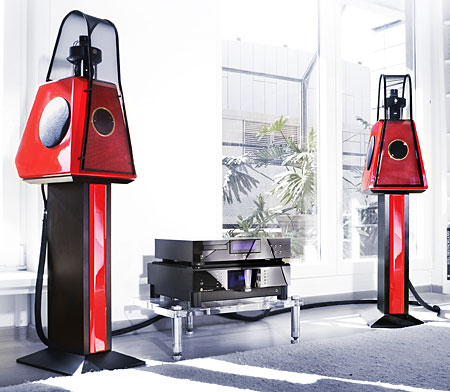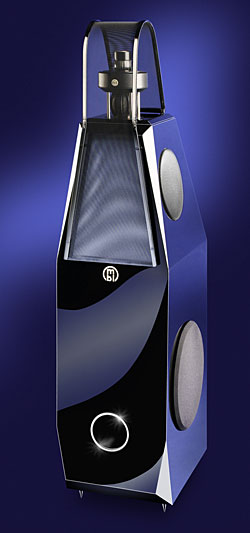mbl Radialstrahler 116/121/111RC 5 Channel Surround Sound System

Dolby specified surround speaker placement to the sides of the listening position, not behind it, which also made dipole/bipole surrounds attractive. Bipoles produce in-phase signals in two directions. Dipoles also radiate in two directions, but the opposing drivers operate out of phase. These out of phase drivers produce a sonic "null" at the front of the speaker. By aiming this null at the listening position, the sound is further diffused by radiating sound to the front and rear of the listening position, but not directly at it.
All of that changed with the introduction of discrete Dolby Digital and DTS 5.1-channel and high-resolution surround sound music formats. While some videophiles still use bipolar or dipolar surround speakers, the ability of mixers to tightly control directionality and place sounds literally anywhere within the 5.1 channel sound field (front to rear, side to side) and move them with lightning-strike speed made directional speakers preferable to those that produce diffuse sound fields.
Nonetheless, speakers firing directly at the listening position can create unwanted localization even if the tweeter has smooth dispersive characteristics. Some designers have turned to quasi omni-directional speakers intended to radiate as uniformly as possible in a 360 degree pattern for all of the system's speakers. TJN reviewed just such a system from Mirage recently featuring quasi-omni-directional speakers ("omnipolar") that use conventional mid and high frequency drivers firing into dispersive diffusers designed to produce near omni-directional performance.
In that review TJN wrote, "In practice there is no such thing as a true omni-directional speaker—a point source that radiates sound equally in all directions." However, there is such a speaker: the mbl 101E Radialstrahler loudspeaker that uses three "bending mode" drivers to cover the frequencies from 105Hz to above 20kHz, radiating them in a true 360 degree pattern. While a conventional cone woofer handles frequencies below 105Hz., low frequencies are inherently omni-directional. [While the mbl 101E Radialstrahler radiates over a full 360 degrees horizontally, and the driver's radiating membranes are curved in a way that produces considerable dispersion above and below the horizontal plane, it does not radiate directly up and down at all frequencies. Think of its radiation pattern as barrel-shaped, with no output from the top or bottom. So it doesn't meet the strictest definition of omnidirectionality—the "pulsating sphere." But until—or if—we can realize that concept, the mbl does come closer than any other speaker I'm aware of.—TJN ]
The only problem with the dramatic looking 101Es for most of us is their cost: $54,890/pr. currently. When I reviewed them for Stereophile back in 2004, there were certainly no problems with their sound. It was glorious, mesmerizing, unforced, non-mechanical and about as silky and natural sounding as I've experienced. They measured well too. "Addictive" was the world Stereophile editor John Atkinson used to describe the tweeter's sound in his measurements comment.
The tweeter's performance was positively hypnotic—easily the best I've heard. And the speaker's overall balance was excellent. mbl had conquered earlier issues of discontinuity resulting from the cone woofer's inability to keep up with the Radialstrahlers' speed.
At $23,870/pr. the more recently developed, more compact mbl 116s cost less than half the price of the 101Es, with the biggest savings coming from replacing the large, lower midrange Radialstrahler driver with conventional cones. Combining these with a pair of mbl's stand-mount 121s ($13,530/pr.) and the 111RC center channel ($8,570) brings the total system cost (not including a subwoofer) to $45,970, which is substantially less than the $54,890 a pair of 101Es costs at today's prices. Add $3,000 for the substantial REL Britannia B1 subwoofer (or the sub of your choice) and the total system cost is still less than a single pair of 101Es. That's still a lot of money, but we're talking about ultimate here aren't we?
 The 116s
The 116s
The sleekly tapered, black piano-lacquer finished, four-way 116 features the MT-50 Radialstrahler midrange and HT-37 tweeter, similar to those found on the more expensive 101E. These drivers, covering 600Hz to 3500Hz and 3500Hz to 33kHz, use a circular vertical array of ultra-thin, flexible carbon fiber membranes ("lamellas") bonded to a thrust bearing on top and connected to a voice coil below. The voice coil motion flexes the membranes outward (and inward), producing a spherical, omni-directional radiating pattern. Two pairs of side-mounted drivers (a pair of 8" front-ported aluminum woofers and a pair of 5.5" aluminum mid-bass drivers in "push-push" configuration) reproduce bass and mid-bass frequencies from 32Hz to 600Hz.
The 121s Surrounds and 111RC Center Channel
Slice the top off of a 116 right where it begins to taper and you have the piano black lacquered 121, which features the 116's midrange/tweeter array along with front vented, double side-mounted "push-push" 5.5" aluminum woofers crossed over at the same 600Hz and 3500Hz frequencies. The 111RC is a 121 that's been phase-optimized and tuned for the 80Hz THX crossover point.
The REL Britannia B1 Subwoofer
This relatively large (15"x26.5"x18.5"), heavy (97 pounds), ultra-flexible subwoofer was used for this review because it was already here, having been part of a Sonus Faber Guarnari speaker review that recently appeared in Stereophile. It was used line level connections, though it can also accept a speaker level output from a full range amplifier.
With its 12" ported, long throw, heavy duty cast frame driver powered by a high-current 500-watt amplifier, the B1 produces prodigious, room-pressurizing, deep bass, down to well below 20Hz (it's spec'd at 13Hz). The B1 makes the difference all too clear between small fart-boxes that produce surprisingly deep, but not stomach-churning low frequencies and ones that make you feel as if your chest is being crushed and your living room is sliding off its foundation! More importantly, it reproduces musical fundamentals with tonal and textural sophistication and a level of overall finesse the small boxes simply can't match. Once dialed in properly, the B1 proved to be a capable match for the mbl system.
Set Up
mbl provides quite specific set up directions for the stereo pair: at least 6.6 feet apart, at least 2.6 feet from the front wall, and a distance to the side walls of approximately 1.5 times the distance between the speakers and the front wall. Hi-fi racks or shelves between the speakers should not be more than approximately 3 feet tall.





























































